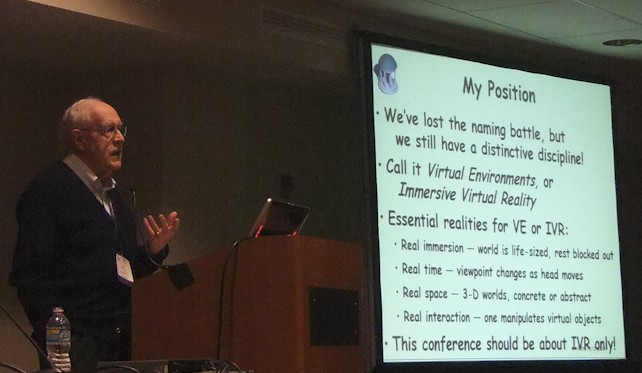Back at Laval Virtual, I was struck about how many people say they’re doing VR where, according to my own (extremist) definition, it wasn’t even remotely VR ! Even some high rank scientists tried to promote their (commercial) application, trying to take benefit of the marketing aura of the term VR, when it was only a desktop and mouse 3d application !!
I’ve already tried briefly in another article to define what is not VR but I didn’t have a very precise definition of what I believe VR is. Everyone in the field has his own definition, and I think I’ve finally found what is the distinctive factor for me (hint, perceptive immersion). Of course now that I’ve realized it I find that I agree with the definition a lot of people.
Anyway for me VR is Immersive Virtual Reality. You can find my definition along with extensive explanations on this page.
There has been a great debate on the 3DUI mailing list about the definition of VR and thus what should the IEEE VR conference be about.
This debate fueled the panel discussing this topic at the IEEE VR 2010 conference, hosted by Jeffrey Jacobson and Chadwick A. Wingrave and prestigious panelists such as Doug A. Bowman, Frederick P. Brooks, Jr., Robert Jacob, Eric Klopfer, Joseph J. LaViola, Jr., Albert (Skip) Rizzo, joined later by Mel Slater. This panel and most of all Mel Slater’s work inspire my position. You can read the slides of this panel here.


I’m happy to report that Fred Brooks is as extremist as me as he said the IEEE VR conference should only be about Immersive VR and nothing else. This would probably shorten the conference a bit, and most certainly avoid keynotes about SecondLife. No more AR, no more multitouch.

Don’t get me wrong, I think SecondLife, AR, multitouch are really important and passionate subjects. It’s just not iVR ! Sometimes some AR or multitouch techniques are used for iVR but that’s not the norm.
So my short definition, for the moment, is :
Immersive Virtual Reality (iVR) is a set of technology and science required for a user to feel present, via perceptive, cognitive and functionnal immersion and interaction, in a generated environment.
Again for a longer and more detailed explanation,  check this page, which will probably evolve in time with my understanding.

Hi! I’ve just read your post and I couldn’t wait to support your claim 🙂
I’m a young PhD student just at the very beginning of his long journey to be a PhD… but I’d been working on an AR development environment (actually, it was the project that I had to present here at Spain at the end of my degree). In the development of my work I was very concerned on making a deep study of what’s AR and what’s not… and it’s not that difficult to find an elegant and simple definition.
But with this last year crazy boom in the AR, people have cannibalized the AR definition in a uncountable number of ways.
After a lot of self-discussions (and some anger) I’ve realized that this perversion of terms comes from the most “commercial” areas. They have changed names to everything and AR/VR terms have been very affected.
With that I’m trying to say that’s researchers’ (and reviewers’) fault to mix concepts because “commercial” areas have and will mix that concepts for their profit. To engage users with the same old things but with new and brand-new cool names.
Good scientists have to respect that de facto definitions even they do not appear in the dictionary, isn’t it?
By the way, I like your definition of iVR, but I’m sure that it doesn’t need the immersive prefix.
I would rather prefer to add a prefix to Second-live’s VR… because that it’s an alternate world in which users project (like in any other video-game!) their minds but not they do not get physically immersed… then it could not be “reality”, isn’t it?
Let’s name it “projected-VR” and leave VR as the real immersive? 🙂
Thanks for your post! See you! 🙂
Thank you for your long comment 🙂
I’d sure love to keep VR, but as Fred Brooks says : “we’ve lost the naming battle ! ”
As we won’t be able to change the definition of the whole world, let’s just accept that we have to change our own definition !
Don’t you think that there are two different battles?
My current point of view is that “scientific” battle needs a powerful ground to be correct and understandable. The “commercial” battle, instead, live on a swamp where if definitions doesn’t move they sink (=loosing money).
Any way to make me think that this is not true? I would also like to be less angry with this and move on with fresh concepts 🙂
The scientific world also has fashion and needs to work on “hype” subjects to get fundings.
So just accept it and move on !
VR is a dead buzzword haunted by the ghost of so many 90s scifi books and films.
The idea of simply wearing a head mounted display that would transport you into another world is fairly simple in it’s approach but ultimately failed in it’s execution.
Most HMDs of the 90s were of low resolution, refresh rate, and field of view. The idea of these HMDs being a parallel to reality was a joke but many media outlets ran with it. It was the game changing future of tomorrow but that tommorow never came.
Even today most HMDs are a joke and the large consumer populace has tired of waiting for such a device and settled with large LCD televisions or HD projectors.
Though the CAVE systems seem to be a fan favorite for iVR enthusiast, corporate dimes and academics. They require far too much space and money to be mass marketed to any consumer base.
This is why the media has lept at any opportunity to label MMOs such as Second Life and World of Warcraft virtual realites. They have nothing else to compare.
But now the new buzz is all around AR and it’s inception into smart phones. Which is a step in the right direction but ultimately this is not VR but could have potential to bring true iVR in the limelight. As holding a phone infront of your face for directions is terrible from an ergonomic stand point.
And with that hopefully we see the likes of virtual retina displays finally coming to mass production within the next five to ten years. These displays aren’t regulated to how many pixels can be produced on a surface of a display but how fast a MEMS device can scan a laser onto the back of your retina.
The plus of this is that it is capable of producing near human vision resolution at high refresh rates.This will be the only true way to produce VR in any traditional sense. Not a large box with six projectors and polarized lenses.
Until then the debate will rage and people will continue to willfully dream VR is just around the corner or just willfully ignore the idea entirely and buy a large 3D television.